|
|
|
Sort Order |
|
|
|
Items / Page
|
|
|
|
|
|
|
| Srl | Item |
| 1 |
ID:
178652
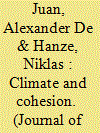

|
|
|
|
|
| Summary/Abstract |
While a large body of research has highlighted the conflict-inducing effects of climate change, we still know very little about the mechanisms linking environmental conditions to violent conflict. This article investigates the plausibility of a prominent channel according to which scarcity of natural resources can foster violent conflict through deteriorating intergroup relations. In addition to assessing the direct effects of adverse environmental conditions on intra-ethnic and inter-ethnic trust, we suggest a conditional argument on the role of horizontal inequality of hazard exposure. Environmental hazards are ‘unequal’ if they systematically affect ethnic groups differently. While inequality may reinforce intra-ethnic ties and out-group suspicion, equal hazard exposure may create a sense of unity among diverse victims in their collective struggle to cope with harsh environmental conditions. We test these arguments in the context of the severe drought periods that affected most East African countries in the years 2004 and 2005. The empirical analysis combines gridded information on drought severity with geo-located survey data across six countries in the region (Afrobarometer survey 2005/2006). Our main analyses find that exposure to drought hazards correlates positively with self-reported trust within and across ethnic groups. The latter association, however, depends on the degree of intergroup equality of hazard exposure and wanes as inequality increases. Taken together, these findings indicate that if droughts increase the risk of violent conflict, they seem to do so through mechanisms other than intergroup polarization and despite their positive association with ethnic trust. This is most likely the case in contexts where there is pronounced horizontal inequality of drought hazards.
|
|
|
|
|
|
|
|
|
|
|
|
|
|
|
|
| 2 |
ID:
148813


|
|
|
|
|
| Summary/Abstract |
Iran has a long history of effective and sustainable water resource management under arid and semi-arid conditions. However, today the country is faced with serious challenges in the water sector, including rising water demand and shortages, declining groundwater levels, deteriorating water quality, and increasing threats to the environment and various ecosystems. If these issues persist, tragedy will be the inevitable result. Over the last three decades tremendous efforts have been made to supply water, primarily through an extensive program of development, with dam building at the forefront. This paper offers an introduction to the different factors and elements influencing the water balance in today’s Iran and presents a perspective on the trend of dam building in recent times.
|
|
|
|
|
|
|
|
|
|
|
|
|
|
|
|
| 3 |
ID:
145990
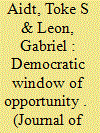

|
|
|
|
|
| Summary/Abstract |
We show that drought-induced changes in the intensity of riots lead to moves toward democracy in sub-Saharan Africa and that these changes are often a result of concessions made as a result of the riots. This provides evidence that low-intensity conflict can have a substantial short-run impact on democratic change and supports the “window of opportunity” hypothesis: droughts lead to an increase in the threat of conflict, and incumbents often respond by making democratic concessions.
|
|
|
|
|
|
|
|
|
|
|
|
|
|
|
|
| 4 |
ID:
192993


|
|
|
|
|
| Summary/Abstract |
This article is concerned with interregional trade dynamics between Elam and Mesopotamia in the early to mid-first millennium BC. During the seventh century BC, two great famines in the Neo-Elamite kingdom, of which climatological changes were a major cause, were documented in the textual records. An era of megadrought made grain procurement from the neighboring regions essential to feed the Neo-Elamite lowland population. This article further explores the impact of the two Neo-Elamite famines and “drought of the century” on the commercial and political mechanisms in the Upper Persian Gulf region.
|
|
|
|
|
|
|
|
|
|
|
|
|
|
|
|
| 5 |
ID:
165216
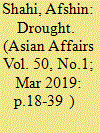

|
|
|
|
|
| Summary/Abstract |
Approximately 97% of the country is experiencing drought conditions. Due to gross water mismanagement and its damaging impact on the country, Iran faces the worst situation in water resources of any industrialized nation. Tens of thousands of villages have been deserted and most of the major urban centers have passed their limits to absorb new rural migrants. Some officials predict that in less than 25 years, 50 million Iranians would be displaced from their current homes because of the pressing ecological conditions. This is happening at the time that the gap between the grassroots and the state has widened and there is increasing dissatisfaction with governance plagued by corruption, nepotism, economic mismanagement, unaccountability and a foreign policy which has produced various regional and trans-regional adversaries. This paper evaluates the pressing ecological challenges in Iran and by conceptualizing political resilience it critically evaluates whether the Islamic Republic is prepared to face the devastating ecological crisis and its socio-economic consequences.
|
|
|
|
|
|
|
|
|
|
|
|
|
|
|
|
| 6 |
ID:
184058
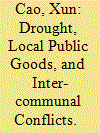

|
|
|
|
|
| Summary/Abstract |
Water charities and the UN development goals consider access to clean water and sanitation as transformative: improving personal dignity, quality of life and economic opportunities for individuals and the economic resilience of communities to climate stress. Can the provision of services also mitigate the conflict potential arising from climate change? If so, how broad must access be to become effective? We test how household access to improved water, sanitation, and electricity affects the probability of local conflict in nine drought-prone African countries. We use annual PRIO-GRID cells as the unit of analysis and model the probability of a grid-cell experiencing fatal armed conflict during local or proximate drought conditions. DHS data are used to calculate the percentage of households with access to specific services. We show that even relatively modest investments in reliable sanitation and water infrastructures enhance communities’ ability to avoid getting drawn into violent conflict in response to rainfall shocks.
|
|
|
|
|
|
|
|
|
|
|
|
|
|
|
|
| 7 |
ID:
175251
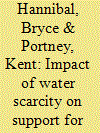

|
|
|
|
|
| Summary/Abstract |
The rise of unconventional oil and gas development in the form of hydraulic fracturing, or fracking, has drawn much attention from media, scholars, and policy makers, and Texas has frequently been the epicenter of this attention. This paper looks at fracking through a particular lens, that of an extraction process that relies heavily on water. This “water-energy nexus” has been studied in terms of the physical connections, but little research exists on how ordinary people might understand that nexus. This paper examines the effect of people's awareness of the water-energy nexus and county-level drought characteristics on their support for increased regulation of water issues associated with hydraulic fracturing. The analysis uses data from a Texas-based public opinion survey, and county-level data from the U.S. Drought Monitor and the Texas Railroad Commission. Multi-level modeling techniques are used to examine the impact of proximity, local water scarcity, and individual awareness of the water-energy nexus on people's willingness to support regulating aspects of water in hydraulic fracturing practices. The paper supports the hypothesis that individual awareness of the energy-water nexus and local water scarcity affects willingness to support greater regulation and concludes with some policy recommendations to improve policy transparency surrounding hydraulic fracturing.
|
|
|
|
|
|
|
|
|
|
|
|
|
|
|
|
| 8 |
ID:
147837
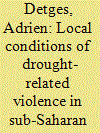

|
|
|
|
|
| Summary/Abstract |
Despite growing concerns about the possible security implications of extreme precipitation shortfalls in vulnerable and politically fragile regions, the particular conditions that make armed violence more or less likely in times of drought remain poorly understood. Using a spatially disaggregated research design and focusing on sub-Saharan Africa, the present analysis assesses how far violent and nonviolent outcomes in the wake of drought can be accounted for by regional differences in the provision of key infrastructures that help coping with drought and preventing violence. The results indicate that civil conflict events in connection with drought are more likely in administrative areas with poorly developed road infrastructures. Drought-related communal violence, on the other hand, is more likely in regions where an important part of the population lacks access to an improved water source. Thus, while the provision of key infrastructures seems to moderate local conflict risks in connection with drought, there are nevertheless important distinctions with regard to different types of infrastructures and forms of armed violence. However, the importance of precipitation shortfalls as a conflict-facilitating factor in sub-Saharan Africa should not be overstated, as the overall contribution of drought measures to predicting violent events is modest in all calculated models.
|
|
|
|
|
|
|
|
|
|
|
|
|
|
|
|
| 9 |
ID:
148940
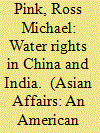

|
|
|
|
|
| Summary/Abstract |
The article explores the paramount human rights and development crisis facing China and India—water scarcity. Both countries are facing alarming water shortages that are exacerbated by dangerous pollution levels, population growth, and climate change impacts such as drought, elevated water-borne disease episodes, flooding, and salt-water intrusion. Millions of citizens in China and India are deprived of safe, clean water in their environment, which threatens healthy socio-economic development. Through the perspective of the human security paradigm, the article analyzes the water security scenario in each country.
|
|
|
|
|
|
|
|
|
|
|
|
|
|
|
|
| 10 |
ID:
167582
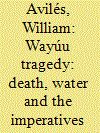

|
|
|
|
|
| Summary/Abstract |
Between 20007 and 2017 approximately 5000 children of the Wayúu tribe in the Guajira state in Colombia died, largely from an inability to gain access to clean water. A severe drought is a proximate factor to this massive loss of life, but the drought concealed a larger historical, political and economic context that was fundamental to this humanitarian crisis. A context dominated by the needs of our present epoch of global capitalism and not simply the consequences of regional corruption or the weakness of the Colombian state. In the case of Guajira, transnational coal mining interests have for decades worked to dispossess indigenous communities from their lands while capturing more of their water resources to facilitate the operation of the largest open-pit mine in the world. This demand for coal, land and water was facilitated by factions of Colombia’s political establishment on a national and regional level that viewed such investments as necessary for development and/or as a source of funding for corruption and political violence.
|
|
|
|
|
|
|
|
|
|
|
|
|
|
|
|
| 11 |
ID:
060308
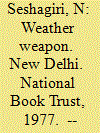

|
|
|
|
|
| Publication |
New Delhi, National Book Trust, 1977.
|
| Description |
ix, 190p.
|
|
|
|
|
|
|
|
|
|
|
|
Copies: C:1/I:0,R:0,Q:0
Circulation
| Accession# | Call# | Current Location | Status | Policy | Location |
| 022951 | 355.82/SES 022951 | Main | On Shelf | General | |
|
|
|
|
| 12 |
ID:
178650
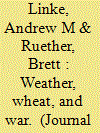

|
|
|
|
|
| Summary/Abstract |
We examine how Syria’s local growing seasons and precipitation variability affected patterns of violence during the country’s civil war (2011–19). Among Syria’s 272 subdistricts (nahiyah), we study conflict events initiated by the Assad regime or its allies, and, separately, by other armed non-government groups (‘rebels’). Throughout the war, violence to capture agriculture has been used regularly to control valuable cropland and harvests. Combatants also seek to deny their adversaries access to these resources by deploying violence to destroy agriculture. We test the hypothesis that conflict was most likely during local growing seasons due to both of these motivations. Additionally, we examine whether unusually dry conditions further elevated the risk of conflict during growing season months. A theory for why higher levels of conflict would occur during unusually dry conditions is that livelihood losses elevate incentives to control scarce crops and also facilitate recruitment of militants or their sympathizers. We find that violent events initiated by the government and rebel groups are both more likely during the growing season than other times of the year. There is also evidence that dry conditions during the growing season led to an increase in government-initiated attacks over the duration of the war. We find the strongest relationship between precipitation deficits and both government- and rebel-initiated violence in later years of the war. Compared with our growing season results, the rainfall deviation estimates are less consistent across models.
|
|
|
|
|
|
|
|
|
|
|
|
|
|
|
|
| 13 |
ID:
161604
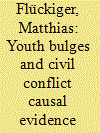

|
|
|
|
|
| Summary/Abstract |
The presence of an exceptionally large youth population, that is, a youth bulge, is often associated with an elevated risk of civil conflict. In this article, we develop an instrumental variable approach in which the size of the youth cohorts in Sub-Saharan Africa is identified using variation in birth-year drought incidence. Our results show that an increase in the size of the population group aged fifteen to nineteen raises the risk of low-intensity conflict. A 1 percent increase in the size of this age-group augments the likelihood of civil conflict incidence (onset) by 2.3 (1.2) percentage points. On the other hand, we do not find any association between the size of the two adjacent youth cohorts, that is, the population groups aged ten to fourteen and twenty to twenty-four.
|
|
|
|
|
|
|
|
|
|
|
|
|
|
|
|
|
|
|
|
|